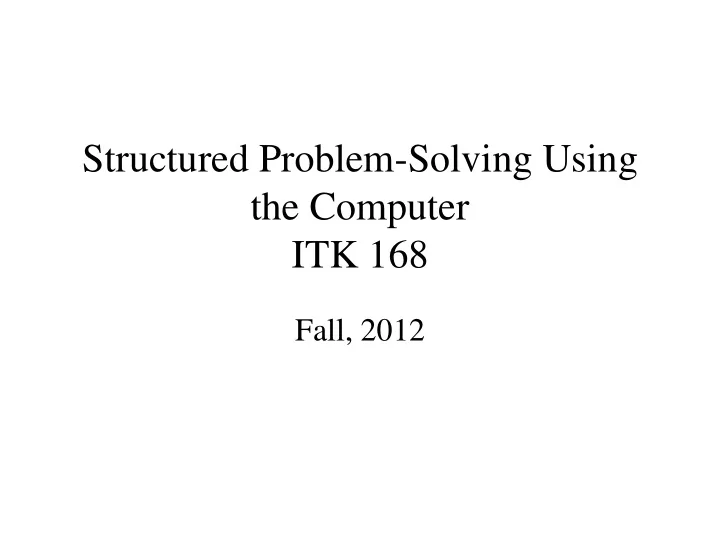

Structured Problem-Solving Using the Computer ITK 168 Fall, 2012
First Questions • What is this course all about? • Why am I taking it? • How much computer experience do I need? • Why Java (and what is Java anyway)?
Syllabus
Assignment for Thursday • Read chapter 1 of your text • Prepare for an in-class quiz over the syllabus and chapter 1
By Next Tuesday • Turn in completed student questionnaire • Send email to mecaliff@ilstu.edu from your preferred email address. Include your name, ITK 168, and your lecture section.
Your Questions
What is a computer?
Parts of a Computer
Parts of a Computer • CPU (Central Processing Unit) • Main Memory (often called RAM) • Secondary Storage • Input • Output
Computer Memory • Sequence of addresses • Important memory terms: – bit – byte – word • Addressing the computer – What’s the difference between 32-bit and 64-bit?
What can a computer do?
What can a computer do? • Simple arithmetic • Move data • Compare two numbers (and move data based on the result of the comparison)
How do we do cool stuff?
Software • System software • Application software
The Process 1. Understand the problem 2. Figure out the interface (input and output) 3. Make a plan 4. Check the plan 5. Translate the plan into Java (or other) 6. Fix compile-time errors 7. Run the program 8. Fix run-time errors 9. Make sure it works correctly
Errors • Syntax or compile-time • Run-time • Logic or intent
Making the Plan • Algorithms • Pseudocode – English – Formatted like computer program code
Terminology • Algorithm ≠ Pseudocode • Algorithms are often written in pseudocode, but your Java program is also a representation of an algorithm. • On the other hand, when I ask you to submit an algorithm, it MUST be written in pseudocode.
Precision/Detail • How precise and detailed does an algorithm have to be? • Just exactly how dumb is a computer?
Writing for an Audience • When you write a computer program, you have two audiences. • What are they?
Demo • Let’s look at an actual computer program in Java.
Recommend
More recommend